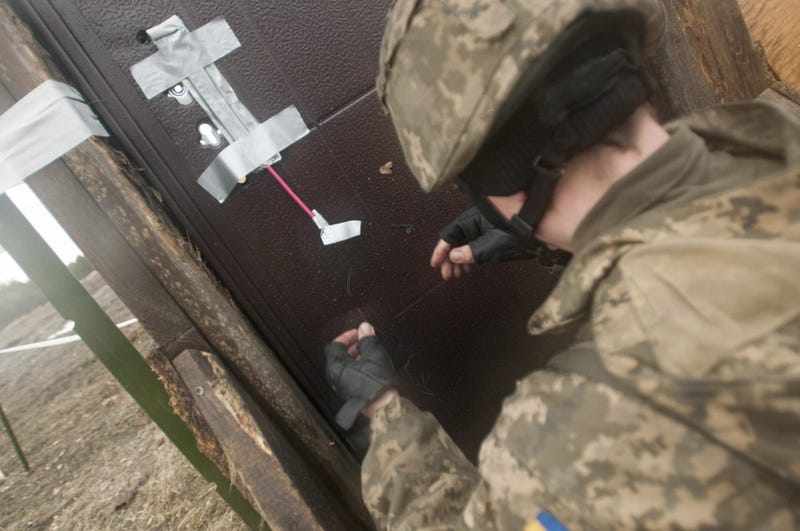
As tensions mount in Ukraine with the Russian military massing their forces, some 127,000 troops, on its western border in a manner that would facilitate, and signal, an imminent invasion, the United States has signaled to Moscow that they could be facing a costly insurgency should they invade.
This international brinksmanship has led to a larger confrontation with the U.S. which has supported Ukrainian independence and opposed Russia's illegal territory annexation of Crimea. Through official and unofficial channels, the U.S. has signaled that if Russia invades they will "pay a serious and dear price for it,” as President Biden stated.

Biden said in a press conference this week that he doesn't believe Putin wants a large-scale war but is rather seeking to test the United States. A war conducted beneath the nuclear threshold, or a conflict that may not involve large military formations, results in the belligerents resorting to cyber warfare, unconventional warfare, and covert action.
This week it was reported that the CIA's Ground Branch paramilitary component has been training Ukrainian Special Forces at a secret location within America and then deploying them back to Ukraine. This program was initiated not long after Russia's initial invasion of Ukraine in 2014, continued through the Trump administration, and to today, according to a half dozen officials cited by Yahoo News.
What exactly these small cells of unconventional soldiers are trained on, and what their actual purpose is, remains unclear. “U.S.-based CIA program has included training in firearms, camouflage techniques, land navigation, tactics like 'cover and move,' intelligence and other areas,” the Yahoo article quotes, which sounds like a rather sanitized description.
For instance, in 2019, then Special Operations Command Europe (SOCEUR) commander Maj. Gen. Kirk Smith was asked about U.S. Special Operations Forces in Ukraine. “From an institutional standpoint, we advise the Ukrainian Special Operations Command on a variety of topics ranging from structure to equipment,” Smith said.
“When we were first asked in 2015 by Ukrainian SOF to assist with their qualification course, U.S. SOF provided a large portion of the class material. Now after multiple iterations, there’s not only a large number of graduates of this new course, but an experienced cadre of trainers who have taken over full responsibility for the training program. Our Soldiers provide advice and assist them with further refinements from an institutional standpoint,” he explained.
With the U.S. military apparently having a robust and successful special ops training pipeline established in Ukraine, it seems unnecessary for the CIA's Ground Branch to relocate Ukrainians to the United States and teach them mundane skills such as camouflage and land navigation. Rather, what it sounds like is that the CIA is training stay-behind units, sleeper cells that would activate behind enemy lines if the Russians ever invaded Western Ukraine.
Some sources in the Yahoo article stated as much saying, "If the Russians invade, those [graduates of the CIA programs] are going to be your militia, your insurgent leaders," an anonymous intelligence official explained. "We’ve been training these guys now for eight years. They’re really good fighters. That’s where the agency’s program could have a serious impact."
But what exactly is the stay-behind mission? Years ago a retired Green Beret explained to me that it is the “lost” 4th infiltration methods. Special Forces can infiltrate enemy territory overland on foot or in vehicles, they can arrive from the sea on boats or swimming subsurface with dive gear, come from the air on helicopters or parachute into denied areas, or they can disguise themselves amongst the civilian population and wait for an enemy invasion to overtake their position. Once in the enemy's rear areas, these stay-behind cells activate and begin conducting acts of sabotage to stymie the enemy's advance.
The United States has a mixed track record with the use of stay behinds in the past. While some programs have been professionally run and staffed, others have been accused of turning into fascist or “black” terrorist networks.
One of the better run programs was Detachment A, which was staffed by active duty U.S. Special Forces soldiers stationed in Berlin. Det A members grew their hair out, wore civilian clothes, and lived off of the local economy. Six 12-man teams had their own assigned targets around Berlin in the event that the Soviets invaded.
Many of their targets revolved around sabotaging the rail lines, others divulged to the author involved knocking out power plants. In time, the Soviets came to know of Det A's existence, but wildly overestimated its size, believing that hundreds of Green Berets were prepared to wage unconventional warfare behind Soviet lines in the event of an invasion.
Many western European nations created their own stay-behind networks starting in the late 1940s. Deeply traumatized by the invasions and occupations of World War II, countries such as Denmark, Switzerland, Italy, Belgium, Germany, Finland, Sweden, Norway, France, and the Netherlands established their own stay-behinds to conduct espionage, sabotage, and aid in escape and evasion using a clandestine communication system routed back to the United Kingdom which was called “Harpoon.”
The stay-behinds in some countries such as Italy and Belgium have been accused of engaging in acts of terrorism as “NATO's secret Army” although the claims and the sources used to make them have been called into question by academics such as Olav Riste who in the Journal of Cold War Studies points out that while there was some coordination with NATO, each country maintained command and control over their own stay-behind units. Many of them transitioned the action or kinetic aspects of their mission to their nation's respective Special Operations units in the 1970s.
Although a full accounting of Europe's stay-behind units has yet to be written, and perhaps never will due to the extreme secrecy surrounding them, Riste's research points out that these networks were active all the way into the 1990s and the Harpoon communications network appears to have been kept active even longer.
“Russia’s occupation and annexation of Crimea in March 2014, and Moscow’s central role in fomenting violent rebellion in eastern Ukraine after the annexation of Crimea have sparked grave anxiety among some new NATO members, especially Poland and the Baltic countries, which want to strengthen allied defenses against Russian military power and expansionist moves,” Riste concludes. “In effect, those states now feel the need for some of the same elements of reassurance that gave rise to the Stay Behind networks of the Cold War.”
Just as how during the Cold War the KGB knew about Detachment A and Europe's stay-behind network, today the United States is once again signaling to Russia that they could be facing an immediate insurgency if they make a move on Ukraine, Estonia, Lithuania, Latvia, or Poland.
Reach Jack Murphy: jack@connectingvets.com or @JackMurphyRGR.
Want to get more connected to the stories and resources Connecting Vets has to offer? Click here to sign up for our weekly newsletter.



